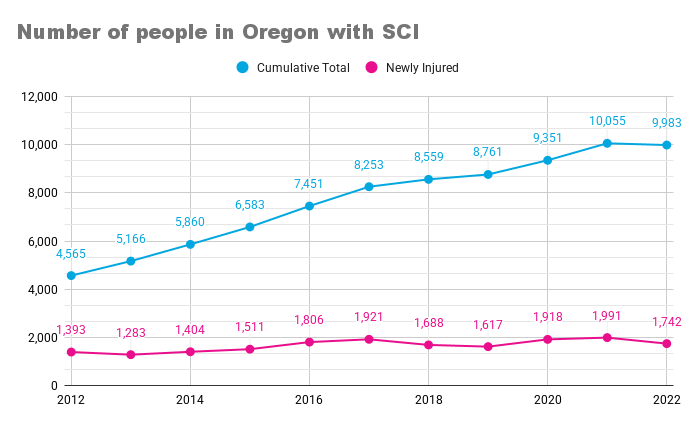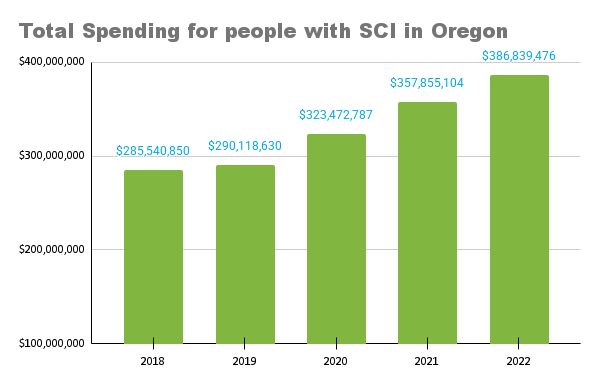SCI Data in Oregon
In 2022, 9,983 people in Oregon lived with a spinal cord injury and spent a total of
$386 million on healthcare—an average of $38,665 per person.
Oregon Spinal Cord Injury Data Report
Quantifying Prevalence, Utilization, Costs, and Health Disparities
Understanding Data in Oregon
Why is reliable data important?
Understanding the true impact of spinal cord injury (SCI) relies heavily on reliable data. Without solid information, it is very difficult to estimate how many people are affected. Crucially, without this reliable data, the individuals living with spinal cord injuries often remain “invisible” to public awareness and policy-making, making it harder to advocate for our needs.
Here’s why reliable data is so important:
- Measuring the Problem: Reliable data allows us to know how many new spinal cord injuries happen each year and how many individuals are currently living with SCI. This helps us understand the overall scope of the problem and begin to advocate for better, more efficient and effective care.
- Influencing Policy and Healthcare:
Reliable data plays a crucial role in shaping government policies and healthcare systems.
When data accurately reflects the prevalence and needs of people with spinal cord injuries (SCI), advocates can push for better services.
Specifically, improved long-term care, rehabilitation, and support services become more achievable with solid evidence.Furthermore, data highlights the benefits of early interventions for people with SCI.
Early treatment can significantly reduce costs linked to common secondary conditions like pressure injuries and urinary tract infections (UTIs).
These cost reductions benefit not only individuals but also the broader healthcare system.
Therefore, using accurate data helps promote both better care and more efficient healthcare spending.
In short, reliable data transforms guesswork into informed decisions. It allows us to advocate for evidence-based changes that can ultimately improve the lives of people living with spinal cord injury, ensuring that our needs are recognized and addressed, and making SCI visible to the rest of the community.
What is APAC and how do they gather data?
Oregon’s All Payer All Claims (APAC) data is a large-scale database designed to provide a comprehensive picture of healthcare costs, quality, and utilization across the state. It systematically gathers and stores detailed information from a wide range of sources, aiming to capture most of the health care activity in Oregon.
What kind of data does APAC collect?
APAC collects administrative health care data that is generated by insurers for purposes like issuing coverage and processing payments. This includes:
- Medical claims: Information on services provided, diagnoses, procedures performed, and amounts paid.
- Pharmacy claims: Details about prescriptions, drug costs, and payments.
- Dental claims: Data related to dental services and associated payments.
- Subscriber billed premiums: The amounts individuals or employers pay for health insurance coverage.
- Member eligibility data: Demographic information about insured individuals, such as date of birth, gender, geography, and race/ethnicity.
- Provider data: Information about healthcare providers, including their location and specialty.
- Alternative payment methods (APMs): Since 2017, APAC also collects data on non-claims payments made by payers to healthcare providers, which are part of newer payment models that focus on outcomes rather than just the volume of services.
How is APAC data gathered?
The Oregon Health Authority (OHA) is responsible for maintaining the APAC database. Data is gathered through a mandatory reporting system, meaning that specific entities are required by Oregon law to submit their claims information to APAC. These entities include:
- Commercial health plans
- Licensed third-party administrators (TPAs)
- Pharmacy benefit managers (PBMs)
- Medicaid (Oregon Health Plan – OHP/CCO and Fee-for-Service)
- Medicare
Organizations submit data to APAC on a rolling schedule throughout the year.
As a result, APAC collects claims data for each period multiple times annually.
This ongoing process accounts for “claims lag,” or the time needed to fully process and adjust submitted claims.
It also allows for corrections, which helps improve data accuracy and completeness.
Because of this timeline, a full calendar year of claims data is usually considered complete about 15 months after the initial deadline.
APAC staff rigorously validate, aggregate, and process the collected data before securely storing it in the APAC data warehouse.
This careful process ensures the data is accurate, consistent, and ready for analysis.
As a result, Oregon can access unbiased, factual information on healthcare costs and service use.
Policymakers, researchers, and health leaders use this data to inform decisions and improve the state’s healthcare system.
Oregon APAC Data on Spinal Cord Injury
The tabs in this spreadsheet show information on Oregon residents diagnosed with a spinal cord injury between January 2011 and December 2022.
These diagnoses were captured through medical claims in Oregon’s All-Payer All-Claims (APAC) database.
Each case reflects a diagnosis that appeared in a submitted claim during that time period.
Additionally, several tabs provide demographic data to support further analysis and understanding of affected populations.
Demographic data tabs include:
- All Years Demographics: Data on all individuals who had a diagnosis of a spinal cord injury in APAC anytime from 2011-2022. (includes individuals who died or left the state during the period under review)
- Demographics By Year: Data on the number of prevalent and incident cases of spinal cord injuries among Oregon residents with data in APAC from 2011-2021 along with key demographic statistics. See definitions of prevalent and incident cases below.
- Geography by Year: Data on the area of residence within Oregon of individuals with a spinal cord injury.
- Mortality: Data on the number of people with a spinal cord injury in Oregon who died each year, based on data from Oregon’s Vital Statistics records, after crossing with APAC demographic data.
- Data Dictionary: Details on how each variable in the databook was defined.
- Diagnosis Codes: The diagnosis codes (ICD-9 and ICD-10) used to identify and define spinal cord injuries.
Before reviewing the data, it is recommended to read through the data notes , as well as the data dictionary.
Data Notes
As you review the spreadsheet data below, please keep in mind important limitations in what the data include and exclude.
Due to these limitations, the counts of prevalent and incident spinal cord injury cases are not fully comprehensive.
Specifically, the data likely undercount the true number of spinal cord injury cases in Oregon.
This undercount occurs because some populations and claims are not captured in the dataset.
Therefore, while the data offer valuable insights, they do not reflect every case across the state.
Limitations related to the Medicare-eligible population:
This databook excludes individuals covered only by Medicare Fee-for-Service during the study period.
APAC’s agreement with the Centers for Medicare and Medicaid Services (CMS) does not allow release of these specific data.
Therefore, spinal cord injury counts for Medicare-eligible individuals—especially those aged 65 and older—are likely under-reported.
Instead, most Medicare data in this report come from Medicare Advantage plans.
Commercial insurers managing these programs submitted the data to APAC.
As a result, only a portion of the total Medicare population appears in this dataset.
For example, in December 2021, Oregon had about 905,289 Medicare-eligible residents.
Of these, approximately 446,541 were enrolled in Medicare Advantage plans.
This means around 49% of the Medicare-eligible population was likely represented in the 2021 data used for this project.
Additionally, some individuals with traditional Medicare may appear in the data.
This occurs if they have pharmacy coverage through a commercial Part D benefits provider.
The percentage of Medicare-eligible individuals in Oregon with Medicare Advantage coverage changed over the time period covered in this booklet.
For instance, in December 2016, only about 43.8% of Medicare-eligible Oregonians had Medicare Advantage coverage.
By contrast, Medicare Advantage enrollment increased in later years, affecting the representation of older adults in the data.
As you interpret trends over time, keep this shift in coverage in mind.
Changes in the number and percentage of individuals aged 65+ with spinal cord injury reflect more than injury rates alone.
They also reflect who was included—or excluded—from the available data.
Earlier years likely show a greater undercount of individuals aged 65 and older.
This is because fewer Medicare-eligible people had Medicare Advantage coverage during that time.
Therefore, the data may more accurately reflect this group in later years compared to earlier ones.
Limitations related to the commercially-insured population:
Before 2016, commercial insurer data in APAC included both fully-insured and self-insured individuals.
In 2016, the U.S. Supreme Court ruled on Gobeille v. Liberty Mutual Insurance Company.
The ruling clarified that states could not require self-insured ERISA health plans to submit data.
After this decision, submitting data on self-insured individuals became voluntary for commercial insurers.
Nearly half of Oregonians with commercial health insurance are in self-insured plans.
Because of this, APAC likely undercounts spinal cord injury cases in the commercial population from 2016 onward.
This gap affects the accuracy of prevalence estimates in the commercial insurance group.
APAC analysts reviewed data from 2018 to assess the impact.
They found that only 36–61% of the self-insured commercial population appeared in APAC that year.
By contrast, about 100% of the fully-insured population was represented.
For more details, see the linked brief.
Other limitations:
In addition to the Medicare and Commercial considerations above, remember that APAC excludes some populations entirely.
For example, APAC does not include any information about people without health insurance.
Moreover, it excludes data from specific federal programs such as Veterans Affairs (VA) and TriCare.
APAC does not capture claims paid by auto insurers for injuries from motor vehicle accidents.
As a result, these missing data sources mean APAC records may not show the full scope of spinal cord injuries.
Therefore, understanding these limitations helps ensure accurate interpretation of the available data.
This spreadsheet shows data on prevalent and incident spinal cord injury cases in Oregon from 2011 to 2022. Because claims data have limitations, and APAC includes only certain information, we must clearly define these terms in context.
Prevalence:
We count a person as having a prevalent spinal cord injury based on several factors and two identification methods.
First, for individuals diagnosed with full spinal cord lesions or paralysis, we begin counting from their first claim in APAC.
Then, they remain prevalent cases for every year they maintain enrollment data in APAC.
For those diagnosed only with partial spinal cord lesions, we count them as prevalent cases for one year after any diagnosis.
However, we only count them during months when they have enrollment data in APAC.
People may lose APAC enrollment for various reasons; for example, they might move out of Oregon, switch insurers, or pass away.
Incidence: We count an individual as having an incident spinal cord injury in the year their first diagnosis appears in APAC data.
First, this diagnosis may represent a truly new spinal cord injury with no prior injury or diagnosis in APAC.
Second, the person may have moved to Oregon and received their first spinal cord injury diagnosis after arriving in the state.
In this case, the diagnosis marks the first time they sought care in Oregon for their condition.
Third, the person may have had a spinal cord injury earlier but used insurance that didn’t report to APAC at the time.
Later, they switched to a plan that does report to APAC, causing the injury to appear as a new case.
In all three situations, we use the first spinal cord injury diagnosis recorded in APAC to determine the year of incidence in our analysis.
Additional Information
National SCI Statistic Center
The National Spinal Cord Injury Statistical Center (NSCISC), located at the University of Alabama at Birmingham (UAB) Department of Physical Medicine and Rehabilitation, supports and directs the collection, management and analysis of the National SCIMS Database.
The National SCIMS Database started in 1973 and collects data from about 6% of new spinal cord injury cases nationwide.
Since then, 31 federally funded SCI Model Systems have contributed data to the database.
As of February 14, 2025, the database included 54,618 individuals with traumatic spinal cord injuries (Registry + Form I).
Researchers apply strict scientific criteria to standardize data collection, management, and analysis across all participating centers.
Additionally, the National Spinal Cord Injury Statistical Center staff developed quality control procedures.
These procedures improve the reliability and validity of the database.
2024 Annual Statistical Report – Public Version
Christopher & Dana Reeve Foundation
The Reeve Foundation is dedicated to curing spinal injury and improving the quality of life for people living with paralysis.
Prevalence and Causes of Paralysis- United States, 2013
In 2012, researchers conducted a national survey using random-digit dialing across over 70,000 U.S. households.
Their goal was to better understand the health and quality of life of people living with paralysis.
The survey defined paralysis functionally, following criteria from the International Classification of Functioning.
Specifically, it described paralysis as a central nervous system disorder that causes difficulty or inability to move limbs.
Researchers identified several conditions causing paralysis, including stroke, spinal cord injury, multiple sclerosis, spina bifida, and cerebral palsy.
Researchers used items from validated surveys like the American Community Survey and the Behavioral Risk Factor Surveillance System.
This approach allowed them to compare people with paralysis, those with other physical disabilities, and people without disabilities.
The survey explored several key areas, including health status and paralysis severity.
It also examined access to healthcare and barriers people face in receiving care.
Additionally, the survey investigated secondary conditions, comorbidities, and healthcare affordability for those with paralysis.
Researchers assessed preventive care use and health risk behaviors within this population.
Secondary Health Conditions and Paralysis Report
Background: Understanding the prevalence of secondary health conditions (SHCs) and their relationship to health status can inform optimal clinical care for persons with paralysis. To date, population-based analyses on these indicators have been lacking.
Objectives: To assess (i) the prevalence, severity and duration by causal conditions of paralysis in a national US adult population; (ii) SHCs by causal condition of paralysis; and (iii) how SHCs, severity and duration of paralysis relate to overall health status.
Design: Cross sectional, population-based study, with negative binomial regression analyses.
Data Source: Secondary data from a nationally representative sample of adults with paralysis. The U.S. Paralysis Prevalence and Health Disparities Survey is a random digit-dial survey of over 70,000 households to identify 1,305 households with a person with paralysis as defined by movement difficulty.
Participants: 1216 adults with paralysis.





